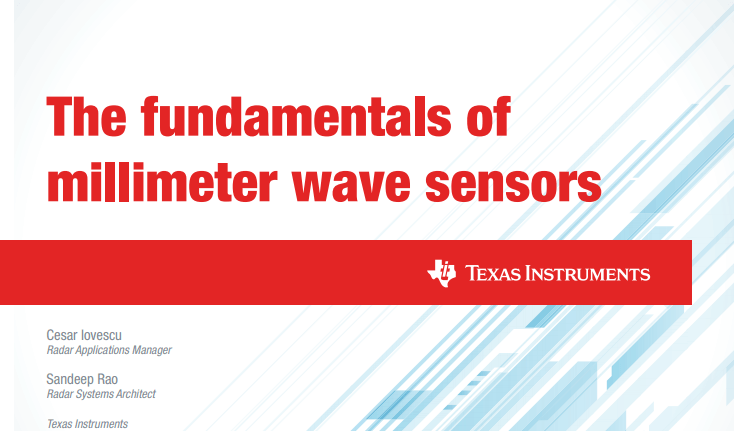Free article: The Fundamentals of Millimetre-wave Sensors
July 12, 2018
on
on

Millimeter-wave (mmWave) is a special class of radar technology that uses short-wavelength electromagnetic waves. Radar systems transmit electromagnetic wave signals that get reflected by objects in their path. By capturing the reflected signal, a radar system can determine the range, velocity and angle of these objects.
mmWave radars transmit signals with a wavelength in the millimeter range. This is considered an extremely short wavelength in the electromagnetic spectrum and is one of the advantages of this technology. Indeed, the size of system components such as the antennas required to process mmWave signals is very small. Another advantage of short wavelengths is the high accuracy. An mmWave system operating at 76–81 GHz (with a corresponding wavelength of about 4 mm), has the ability to detect movements as small as a fraction of a millimeter.
A complete mmWave radar system includes transmit (TX) and receive (RX) radio frequency (RF) components; analogue components such as clocking; and digital components such as analogue-to-digital converters (ADCs), microcontrollers (MCUs) and digital signal processors (DSPs). Traditionally, these systems were implemented with discrete components, which increased power consumption and overall system cost. System design is challenging due the complexity and high frequencies.
Texas Instruments (TI) has solved these challenges and designed complementary metal-oxide semiconductor (CMOS)-based mmWave radar devices that integrate TX-RF and RX-RF analogue components such as clocking, and digital components such as the ADC, MCU and hardware accelerator. Some families in TI’s mmWave sensor portfolio integrate a DSP for additional signal-processing capabilities.
TI devices implement a special class of mmWave technology called frequency-modulated continuous wave (FMCW). As the name implies, FMCW radars transmit a frequency-modulated signal continuously in order to measure range as well as angle and velocity. This differs from traditional pulsed-radar systems, which transmit short pulses periodically.
Click here to read the full article by Cesar Iovescu and Sandeep Rao (Texas Instruments).
mmWave radars transmit signals with a wavelength in the millimeter range. This is considered an extremely short wavelength in the electromagnetic spectrum and is one of the advantages of this technology. Indeed, the size of system components such as the antennas required to process mmWave signals is very small. Another advantage of short wavelengths is the high accuracy. An mmWave system operating at 76–81 GHz (with a corresponding wavelength of about 4 mm), has the ability to detect movements as small as a fraction of a millimeter.
A complete mmWave radar system includes transmit (TX) and receive (RX) radio frequency (RF) components; analogue components such as clocking; and digital components such as analogue-to-digital converters (ADCs), microcontrollers (MCUs) and digital signal processors (DSPs). Traditionally, these systems were implemented with discrete components, which increased power consumption and overall system cost. System design is challenging due the complexity and high frequencies.
Texas Instruments (TI) has solved these challenges and designed complementary metal-oxide semiconductor (CMOS)-based mmWave radar devices that integrate TX-RF and RX-RF analogue components such as clocking, and digital components such as the ADC, MCU and hardware accelerator. Some families in TI’s mmWave sensor portfolio integrate a DSP for additional signal-processing capabilities.
TI devices implement a special class of mmWave technology called frequency-modulated continuous wave (FMCW). As the name implies, FMCW radars transmit a frequency-modulated signal continuously in order to measure range as well as angle and velocity. This differs from traditional pulsed-radar systems, which transmit short pulses periodically.
Click here to read the full article by Cesar Iovescu and Sandeep Rao (Texas Instruments).
Read full article
Hide full article


Discussion (0 comments)